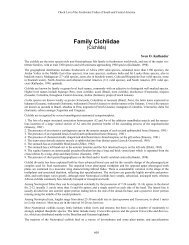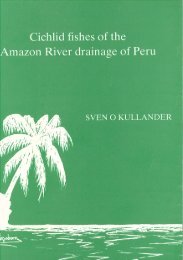Open Access PDF - Sven Kullander
Open Access PDF - Sven Kullander
Open Access PDF - Sven Kullander
You also want an ePaper? Increase the reach of your titles
YUMPU automatically turns print PDFs into web optimized ePapers that Google loves.
344<br />
caudal fin base, blackish blotch at caudal fin base,<br />
and narrow greyish vertical bars 1-3. Light spots<br />
visible on dorsum.<br />
In young specimen photographed alive near<br />
Altair (Fig. 47), estimated to be about 150 mm SL,<br />
horizontal band absent, bars 1-3 distinct, crossing<br />
side from dorsum to below level of pectoral fin<br />
base, also one or two very narrow dark vertical<br />
markings between principal bars. Dorsum and<br />
middle side with about five irregular rows of<br />
yellowish spots.<br />
Large adult, estimated length 300 mm SL,<br />
photographed alive in São Felix do Xingu (Stawikowski<br />
& Werner, 2004: 39, upper photo) overall<br />
blue green with yellow branchiostegal membrane.<br />
Colour pattern obscured by reflections, but obviously<br />
including narrow vertical bars and small<br />
light spots on middle of side and caudal peduncle.<br />
Two adult market specimens (Fig. 48) photographed<br />
at Balneário do Pedral display small<br />
nuchal protuberances, and may be in breeding<br />
colour. Side yellowish, abdomen and underside<br />
of head white. Black vertical bars prominent, from<br />
dorsum to about level of pectoral fin base. Numerous<br />
minute, light-margined black spots scattered<br />
over side; similar small spots also on side of head<br />
but few and much smaller. Indications of a medial<br />
bar 1a in one specimen and bar 2a in one<br />
specimen. Caudal ocellus ringed with gold.<br />
Geographical distribution. Only three localities<br />
in the lower Rio Xingu drainage are verified by<br />
preserved material (Fig. 9). The Balneário do<br />
Pedral is located on the Rio Xingu about 8 km<br />
from Altamira. The type locality, Cachoeira do<br />
Espelho is located 13 km south of Altamira. The<br />
third locality, Gorotire, is located on the lower<br />
course of the Rio Fresco. At Balneário do Pedral,<br />
specimens were collected in shallow water,<br />
pH 6.5, less than 1 dGH, and temperature 30-<br />
32 °C, in strong current among lava rocks (Stawikowski<br />
& Werner, 2004: 40).<br />
Etymology. Named for Melanie L. J. Stiassny,<br />
Curator of Fishes in the American Museum of<br />
Natural History, in recognition of her significant<br />
contribution to cichlid systematics.<br />
Notes. Cichla melaniae occurs in the Xingu river<br />
drainage downstream from localities of C. mirianae.<br />
Because both species are known only from<br />
few localities and few specimens from each local-<br />
ity it may, however, be premature to conclude<br />
that they are allopatric.<br />
The two species differ in the colour pattern of<br />
young and adults. No juveniles are known of<br />
C. mirianae, but specimens about 100 mm are<br />
known from both species. At this size, C. mirianae<br />
displays distinct lateral ocelli, whereas C. mela niae<br />
displays only narrow vertical bars. This colour<br />
difference persists in larger specimens, and<br />
C. melaniae also displays a pattern of minute black<br />
and white spots on the middle side as adult commonly<br />
with the black spots margined with white,<br />
unlike C. mirianae which never shows minute<br />
black spots on the side except for those contained<br />
in the irregular lateral band, which in turn is<br />
absent (but cf. below) from C. melaniae.<br />
Photographs of large specimens of Cichla in<br />
the aquarium trade said to come from the Rio<br />
Xingu, exemplified by Stawikowski & Werner<br />
(2004: 39, lower photo), depart in colour pattern<br />
from that of preserved specimens and photographs<br />
of fresh caught specimens by displaying<br />
a narrow, irregular black horizontal band along<br />
the side, margined with white, only faint greyish<br />
vertical bars, and one or two vertical bars of same<br />
colour between the principal bars.<br />
Cichla piquiti, new species<br />
(Figs. 49-54)<br />
Holotype. MZUSP 40296, young male, 219 mm<br />
SL; Brazil: Pará: Rio Itacaiúnas at Caldeirão; Apr-<br />
May 1983, M. Goulding.<br />
Paratypes. 56 specimens, ca. 20-430 mm SL. Brazil:<br />
Rio Araguaia drainage: MZUSP 50240, 4,<br />
184-249 mm SL; Mato Grosso: Rio das Mortes;<br />
1950, Expedição Butantan. – MZUSP 50242, 3,<br />
212-214 mm SL; Goiás: Lago Rico, near Cocalinho;<br />
Mar 1976, EMGOPA. Rio Tocantins drainage:<br />
INPA 24063, 2, 207-220 mm SL; Pará: Rio Tocantins,<br />
Itupiranga; Nov. 1980, Equipe de Ictiologia<br />
do INPA. – MZUSP 40397, 3, 127.9- ca 143 mm SL;<br />
Goiás: mun Flores de Goiás, Fazenda Fortaleza,<br />
Rio Macacos, tributary to Rio Macaquinhos; 10<br />
Sep 1988, J. C. de Oliveira et al. – MZUSP 40926,<br />
1, 298 mm SL, 2, ca 43- ca 68 mm SL; Goiás: mun<br />
Flores de Goiás, Fazenda Olho d’Agua, Poço do<br />
Gandaia, marginal lake of Rio Paranã; 21 Jan 1989,<br />
J. C. de Oliveira et al. – MZUSP 50256, 4, 97.1-<br />
126.3 mm SL; Pará: lagoa at Jatobal; 16 Sep 1970,<br />
EPA. – NRM 12711, 1, 146.6 mm SL; Pará: harbour<br />
<strong>Kullander</strong> & Ferreira: Review of Cichla




